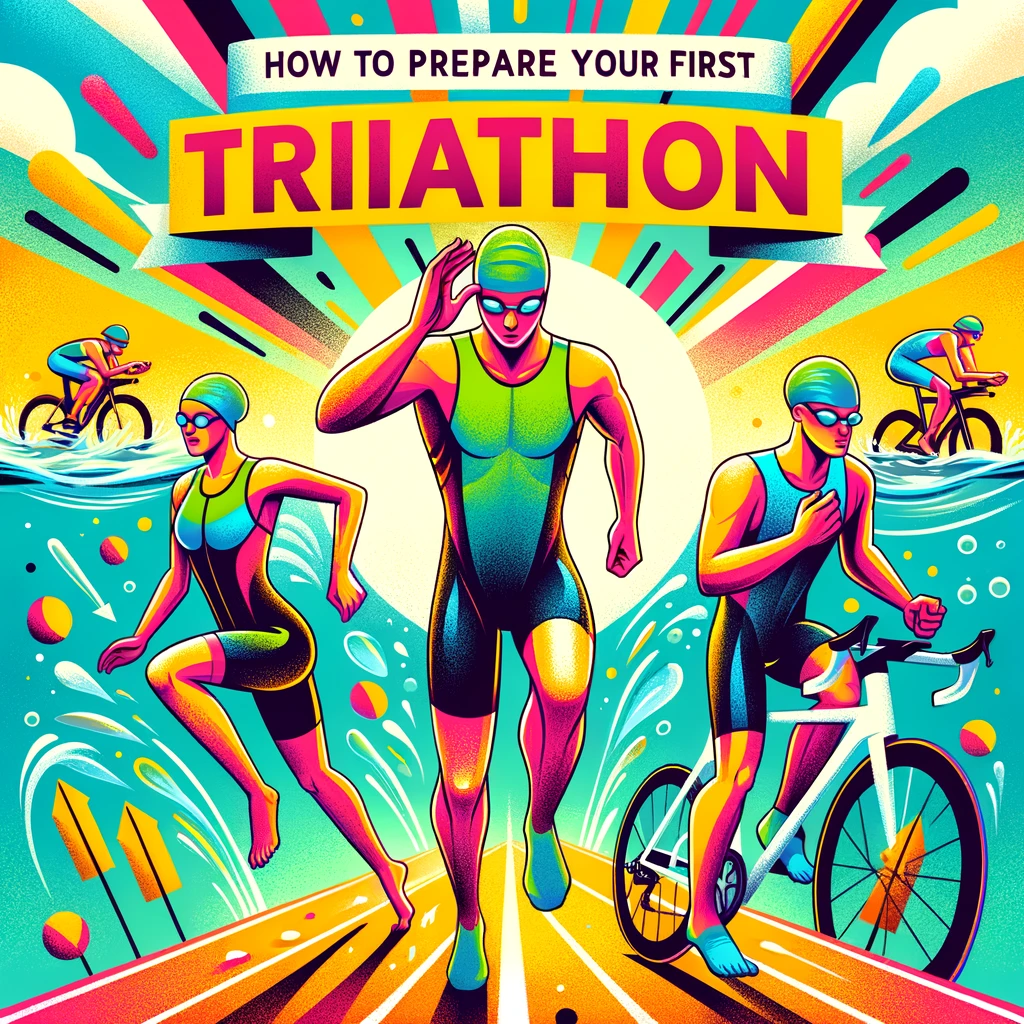So, you’ve decided to do a triathlon. Congrats! You’re officially a brave (and slightly insane) human being. But let’s be real for a second—preparing for your first triathlon can be as overwhelming as trying to solve a Rubik’s Cube while blindfolded. Between the swimming, biking, and running (oh, the running!), you might wonder, “Am I really ready for this?” But fear not! With the right triathlon preparation for beginners, a solid triathlon training plan, and a few triathlon tips for beginners, you’ll be crossing that finish line in no time. Or at least, in a reasonable amount of time.
What Exactly is a Triathlon?
For the uninitiated, a triathlon consists of three sports: swimming, cycling, and running, all rolled into one event. It sounds intense because, well, it is. But it’s also one of the most rewarding challenges you can take on.
- Swimming: Usually done in open water (lake, river, or ocean) or a pool, this is the first leg of the race.
- Cycling: After your swim, you hop on your bike for the cycling portion.
- Running: To top it off, you finish with a run. This is where you’ll probably be questioning all your life choices, but hey, at least the finish line is in sight!
Now, let’s break down the steps to help you survive—uh, I mean, prepare for your first triathlon.
Step 1: Get Familiar with the Distances
Before you even think about training, you need to decide which type of triathlon you’re going to do. Each has a different distance, and trust me, it matters!
| Triathlon Type | Swim | Bike | Run |
|---|---|---|---|
| Sprint Triathlon | 750m | 20km | 5km |
| Olympic Triathlon | 1.5km | 40km | 10km |
| Half Ironman | 1.9km | 90km | 21.1km |
| Full Ironman | 3.8km | 180km | 42.2km |
If you’re a beginner, start with a Sprint triathlon. It’s still challenging but not so much that you’ll need a week off work to recover. Baby steps, right?
Step 2: Building a Triathlon Training Plan
The 3-Sport Dilemma
Unlike a marathon where all you have to worry about is putting one foot in front of the other (for hours on end), a triathlon requires you to be proficient in three different disciplines. This means your triathlon training plan needs to address all three.
Here’s the good news: you don’t need to train like an Olympic athlete (unless you want to). For most beginners, 3-4 days of training per week is enough to get you race-ready. That said, balancing all three sports takes a bit of planning. Here’s a simple beginner’s triathlon training schedule:
Sample Weekly Training Plan
| Day | Activity |
|---|---|
| Monday | Rest day (Yay!) |
| Tuesday | Swim 30 mins |
| Wednesday | Bike 45 mins |
| Thursday | Run 30 mins |
| Friday | Swim 30 mins + Strength Training |
| Saturday | Long Bike Ride (60-90 mins) |
| Sunday | Brick Workout (Bike + Run) |
A “brick workout,” by the way, is when you combine two disciplines back-to-back, like cycling and running. It’s called a brick because, well, your legs will feel like bricks when you try to run after biking. Fun, right?
Step 3: Swimming Tips for Beginners
Open Water vs. Pool
Most triathlons have an open water swim, which can feel completely different from doing laps in your local gym pool. Picture this: instead of clear water and nice lanes, you’re in a lake with murky water and 50 other swimmers all vying for the same spot. Oh, and there’s no wall to kick off from. Excited yet?
Here’s how to prepare:
- Practice open-water swimming: If you live near a lake or the ocean, start practicing in open water. The unpredictability will help you get used to race day conditions.
- Sight frequently: In open water, there are no lane lines to keep you on track. You’ll need to “sight” (look up occasionally) to make sure you’re not swimming off into the sunset.
- Get comfortable with wetsuits: If your race is in cold water, a wetsuit is your new best friend. It helps with buoyancy and warmth, but it feels a bit like wearing a full-body Spanx, so practice in it beforehand!
Step 4: Cycling – It’s Not Just About Speed
Cycling is the longest part of the triathlon, so it’s important to be comfortable on your bike. The biggest rookie mistake is focusing only on speed. Sure, you want to go fast, but you also need to conserve energy for that pesky little run at the end.
Cycling Tips for Beginners:
- Get a bike fitting: Your bike should feel like an extension of your body. A professional bike fit will make you more efficient and reduce the risk of injury.
- Train on hills: Even if your race is flat, training on hills will build leg strength and improve your overall performance. Plus, it makes riding on flat terrain feel like a breeze!
- Invest in padded shorts: Trust me, your bum will thank you.
Oh, and one more thing: learn how to fix a flat tire. You don’t want to be stuck on race day waiting for roadside assistance, do you?
Step 5: Running After Biking – The Jelly Legs
Running after biking feels a bit like trying to run on jello. It’s called “transition legs,” and yes, it’s as awkward as it sounds. But with practice, you can train your body to adjust more quickly.
Running Tips for Triathletes:
- Do brick workouts: The more you practice going from bike to run, the easier it’ll get. Your legs will eventually catch on to the fact that they need to switch gears.
- Focus on form: After biking, it’s tempting to shuffle along like a zombie, but maintaining good form will help you finish stronger.
- Start slow, then build: Your legs might feel heavy at first, but don’t panic. Start slow, and once your legs loosen up, pick up the pace.
Step 6: Nail Your Transitions
Transitions (T1 from swim to bike, T2 from bike to run) are often called the “fourth discipline” of triathlon. And believe it or not, they can make or break your race.
Transition Tips:
- Practice, practice, practice: Set up a mini transition area at home and practice going from swim to bike and bike to run. Time yourself!
- Keep it simple: On race day, your brain will be foggy, so keep your transition area simple. Lay out your gear in the order you’ll need it.
- Don’t forget nutrition: Use your transitions to hydrate and fuel up. Trust me, you’ll need the energy later on.
Step 7: Race Day Tips
Pack Your Gear the Night Before
Triathlons require a lot of gear—wetsuit, goggles, bike, helmet, running shoes, and more. The last thing you want to do is forget something important (like your bike!) on race day. Pack your bag the night before and use a checklist to make sure you have everything.
Race Day Checklist:
- Wetsuit
- Goggles
- Bike (don’t laugh, people forget)
- Helmet
- Sunglasses
- Cycling shoes
- Running shoes
- Water bottles
- Energy gels/snacks
Arrive Early
Race mornings are chaotic, so give yourself plenty of time to set up your transition area, check your gear, and mentally prepare. You don’t want to be sprinting to the start line before the gun goes off!
Step 8: Enjoy the Experience!
Finally, remember to enjoy the experience. Your first triathlon is about more than just crossing the finish line; it’s about pushing your limits, discovering what you’re capable of, and maybe even having a little fun along the way (yes, fun!).
No matter your finishing time, completing a triathlon is an incredible achievement. So, high-five yourself (and maybe your training buddy) when you cross that finish line. And hey, maybe treat yourself to a cheeseburger afterward—you’ve earned it!
Final Thoughts
Preparing for your first triathlon is a journey. It’s filled with early mornings, sore muscles, and occasional moments of “What was I thinking?” But it’s also an adventure that will push you out of your comfort zone and make you feel like a total superhero.
With the right triathlon training plan, some triathlon tips for beginners, and a healthy sense of humor (you’ll need it), you’ll be ready to tackle that race head-on. Now go out there, have fun, and remember: one stroke, one pedal, and one step at a time!

